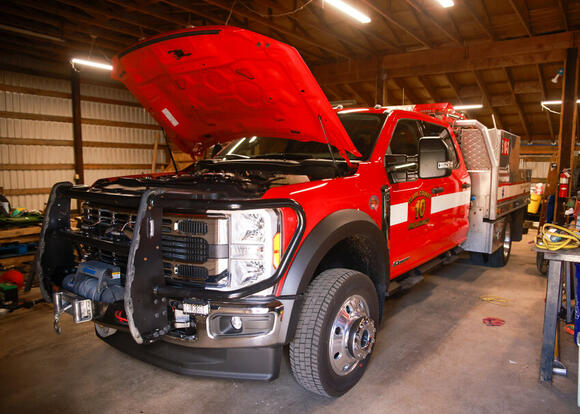
Clark County Fire District 10 saves costs on equipment and builds valuable wildland firefighting experience as the “not if, but when” Clark County wildfire looms this season without Larch inmate crews.
Clark County passed the first test this summer season with zero major fires caused by Fourth of July fireworks, but, as of press time, the outcome from the heat wave was still unknown.
Fire District 10, a mostly volunteer agency, serves the northern reaches of Clark County with headquarters in Amboy. The district has always utilized Larch inmate crews as they assisted with numerous wildland firefighting operations. This time around, a single 10-person hand crew is stationed just north of Camas, while the Larch Corrections Center had the ability to house upwards of nine crews.
“This is not the first time that the Department of Corrections tried to do that, and what I see is it’s going to be a domino effect, kind of thing,” Fire District 10 Chief Gordon Brooks said. “The [Department of Natural Resources] engine crews are going to spend more time on incidents now in the other areas, so they won’t be as readily available for the initial attack work, and they are primary first assistants in many of those kinds of fires.”
To be better prepared to attack Clark County wildfires, Brooks and his department recently responded to wildfires in the Yakima Valley. The work FD10 crews did on the eastern side of the state was mainly what the Larch inmate crews provided the southwest Washington region. The experience gained by Fire District 10 personnel is a positive for the area even while the resource from Larch is lost.
“I was working with a strike team of our engines on the Yakima Reservation, and so we ended up doing work that would ordinarily be considered hand-crew work because it was not available even over there,” Brooks said. “And so that’s some place that you would frequently see the Larch crews doing that kind of work, working through brush, chopping the brush down, moving it out of the way and then digging underneath it, and so that kind of work fell to us because we were the only resource available.”
While staff with Fire District 10 gain valuable wildfire experience outside of Clark County, back in the shop in Amboy, FD10 saves costs by building up its own units. Staff are currently building up a new brush truck and “tool box” type-three engine that has a larger water capacity, ability to pump up to half a mile of hose line, and house enough tools for two hand crews.
“We can save a lot of money,” Brooks said, especially with new Ford F-550 brush trucks. “So we purchase the chassis through the Washington state Department of Procurement, and we purchase the chassis at around $80,000. We reuse the bed that was $17 to $18,000 to purchase and do the work ourselves. To purchase this truck is like $220,000, and so we figure using the labor of staff that are here for 48 hours at a time to do that work, we can cut the costs in about half. So that’s what we’re doing: everything we can to maximize our taxpayers’ dollars because we’re taxpayers here, too.”
Even with the Department of Natural Resources (DNR) wildland fire crews readily available in the area unless a major fire strikes elsewhere in the region, Fire District 10 personnel will continue to remain on scene for fire suppression support. Brooks mentioned a recent fire that DNR took over from local agencies, but FD10 had a water tender remain on scene. Clark-Cowlitz Fire Rescue, a neighboring fire district, initially needed further support, so FD10 sent a water tender, which worked with the DNR fire crews.
“DNR doesn’t have water tenders. So when they got there and needed to finish that mop up work, they hired our tender and kept our tender on scene after Clark-Cowlitz Fire Rescue crews went back,” Brooks said. “And so … our water tenders are available as an additional resource for DNR, now. Those Larch crews — those hand crews — 60 people… would use to basically get out and churn up the dirt, find the last of the crumbs of the fire. Most of the time, if a fire line needed to be dug around here, it was done by Larch crews, and now we don’t have that resource available.”
The Larch Corrections Center, east of Hockinson, went into a “warm closure” in October 2023, with inmates no longer staying in the minimum-security facility. Among the inmates at the corrections center were inmate wildland fire crews that served the southwest Washington region.
“So it’s going to keep our staff, the DNR engine staff on scene longer and kind of keep us away from the primary mission that people see us for anymore. Right now, 80% of our calls are non-fire calls, traffic accidents, sick people, someone falls out of bed and needs help at two in the morning to get back into bed, that’s us,” Brooks said. “And so those kinds of things are at risk of being delayed, and that’s really going to be the biggest impact is the delays in helping our citizens. I don’t know why the Department of Corrections chose to close [the] Larch camp. To me, it is valuable to have that resource spread throughout the state. Now, the Clark County area is the largest urbanized area without a minimum security corrections center around.”
 Most Popular
Most Popular

Comments / 0